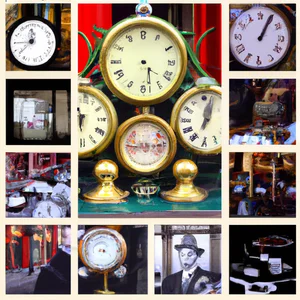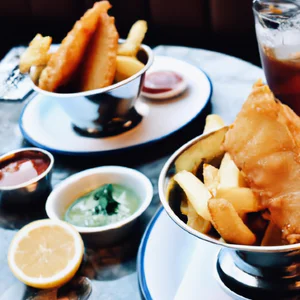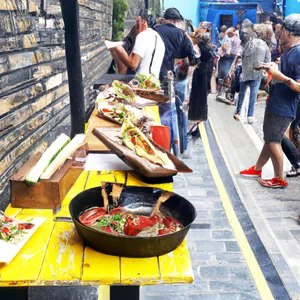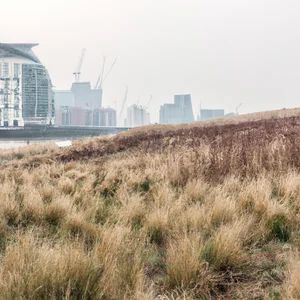Book your experience
Fusion cuisine in London: when East meets West in the most innovative dishes
Fusion cuisine in London: a journey where the East mixes with the West in truly unique dishes
So, let’s talk about fusion cuisine in London, which is practically a laboratory of flavours, where East and West join hands and create dishes that will leave you speechless! It’s as if one day, while walking through Covent Garden, I stumbled upon a little restaurant that seemed to have come out of a dream. There was a guy making sushi burritos! Yes, you read right, sushi and burrito together. And honestly, I thought it was a little weird, but then I tasted it and wow, it’s the bomb!
But let’s talk about what makes this cuisine so special. The truth is that in London, there is a mix of cultures that is almost palpable. You sit at the table and, while waiting for your order, you can hear chatter in a thousand different languages. It’s as if the whole world had gathered there to discover new flavours. And, trust me, it’s not just a gimmick to impress tourists. It is a real embrace of culinary traditions which, mixed together, give life to something incredible.
Of course, not all fusions work, eh! Sometimes you find yourself faced with dishes that seem more like a chemistry experiment than a meal. But when things go well, well, it’s like a symphony for the taste buds. I remember once eating a Thai curry with a touch of Neapolitan-style tomato. And I swear, I didn’t think it would work, but every bite was like a revelation!
And then it must be said that the creativity of these chefs is truly to be admired. Some of them, perhaps, are not so sure, but they have the courage to try. And this is the beauty of fusion cuisine: it’s a bit like dancing a tango between tradition and innovation. Sometimes you wonder if it’s really possible, but then, every now and then, you may discover a dish that makes you say, “Wow, why didn’t I think of that before?”
In short, if you are in London and want to live a culinary experience that is a real feast for the senses, you can’t miss fusion cuisine. It’s a journey that takes you to unexpected places, and, who knows, maybe you too will find a dish that will change your life!
The best fusion restaurants to try in London
When I ventured into the vibrant neighborhood of Shoreditch, I was greeted by an enveloping scent of spices and aromas dancing in the air. It was a spring evening and, scrolling through reviews on a restaurant app, I came across a fusion restaurant that promised to combine Asian and European traditions in ways I’d never seen before. The restaurant was called Dishoom, an homage to Bombay’s famous Indian cafes, where iconic dishes like chicken tikka and naan bread mix with British influences. From that moment, I understood that London is a culinary crossroads, a place where the past merges with innovation.
Restaurants not to be missed
If you’re looking to explore the fusion cuisine scene in London, here are some of the best restaurants to try:
Hoppers: This restaurant celebrates Sri Lankan cuisine, with dishes such as kottu roti, a mix of fried bread and meat, and hoppers, crepes made with rice and coconut. A culinary experience that goes beyond traditions.
Benares: Located in the heart of Mayfair, this Michelin-starred restaurant offers a contemporary interpretation of Indian dishes, with fresh ingredients and innovative techniques. Don’t miss their tandoori lamb chops.
Sushi Samba: For a 360-degree experience, this restaurant on the 38th floor of Heron Tower combines Japanese, Brazilian and Peruvian cuisine. The view is as spectacular as the menu!
Insider tip
Little-known tip: Many fusion restaurants offer tasting menus at reduced prices on weekdays. Check their websites or sign up for their newsletters to stay updated on these offers. You may discover incredible dishes at a more affordable price.
Cultural and historical impact
Fusion cuisine in London isn’t just a fad; it is the result of a rich cultural fabric that embraces communities from all over the world. In recent decades, London has seen an increase in immigration, bringing with it culinary traditions that have intertwined and transformed. Fusion cuisine is therefore a reflection of this diversity, a way to celebrate the meeting of cultures.
Sustainability and responsibility
Many of the restaurants mentioned are committed to sustainability, using local and organic ingredients whenever possible. For example, Dishoom has started working with local farmers to ensure their raw materials are fresh and responsible.
An experience worth trying
If you fancy exploring fusion cuisine, sign up for a cooking class at The Cookery School on Little Portland Street. You will be able to learn to prepare fusion dishes under the guidance of expert chefs, bringing home not only recipes, but also a new understanding of culinary techniques.
Final reflection
It is often thought that fusion cuisine is just a random mix of ingredients, but in reality it is an art that requires attention, creativity and respect for traditions. The next time you explore London, consider trying a fusion restaurant and be amazed by the harmony of flavors that emerge in the dishes. What’s your favorite fusion dish?
Iconic dishes: where East meets West
A Personal Experience
I still remember my first encounter with fusion cuisine in London, sitting in a restaurant hidden in the lively neighborhood of Shoreditch. I ordered a dish that seemed like a tribute to Japanese tradition, but with an Indian touch: sushi with a tandoori chicken filling. The explosion of flavors hit me like lightning, and I realized that fusion cuisine was not just a trend, but a true celebration of cultural encounter.
The Best Fusion Restaurants
If you wish to explore this fascinating gastronomic world, London offers numerous options:
- Dishoom: Inspired by Bombay restaurants, it is famous for its breakfast naan and black daal which go perfectly with English classics.
- Zuma: Here sushi meets European ingredients in an elegant and lively setting, making each dish a work of art.
- Roka: With its robata grill, Roka combines Japanese cuisine with Western influences, creating dishes such as marinated black cod.
An Unconventional Advice
If you want a truly authentic experience, I recommend booking a table at Koya Bar, where the udon noodles are freshly prepared. Here you will not only find fusion dishes, but also a fusion of cultures, with customers ranging from locals to tourists. It is the ideal place to discover how culinary traditions intertwine.
Cultural and Historical Impact
Fusion cuisine in London is a reflection of the city itself: a melting pot of cultures and traditions. In recent decades, globalization has transformed the way we cook and eat, allowing chefs to draw on a wide range of influences. From a simple plate of noodles to a sophisticated multi-course dinner, each dish tells a story of connection and innovation.
Sustainable Practices
Many fusion restaurants in London are embracing sustainable practices, using local and seasonal ingredients. Dishoom, for example, collaborates with local producers to ensure freshness and quality, while reducing its ecological footprint.
An Activity to Try
For total immersion, join a food circuit that will take you to explore the city’s most iconic fusion restaurants. These guided experiences will not only let you taste delicious dishes, but will also tell you about the history and traditions behind each dish.
Myths to dispel
A common myth is that fusion cuisine lacks authenticity. In reality, the best fusion restaurants respect culinary traditions while reinventing them, creating a dialogue between the various gastronomic cultures. Don’t be afraid to experiment: the results can be surprising.
Final reflection
As you explore London’s iconic dishes, ask yourself: How can cuisine bring together different people and cultures? The next time you enjoy a fusion dish, remember that you are having an experience that goes beyond simple nourishment; it is a journey through time, space and traditions. Fusion cuisine is an invitation to explore and celebrate differences, one bite at a time.
Surprising ingredients: the magic of fusion cuisine
A personal experience
I still remember my first encounter with fusion cuisine in a small restaurant in Camden. I ordered a sushi burrito, an idea that seemed extravagant but turned out to be an incredible sensory experience. The freshness of the raw fish wrapped in a warm tortilla and filled with avocado, soy sauce and crunchy vegetables created an explosion of flavors that I never imagined could exist. This gastronomic encounter opened my eyes to the magic of fusion cuisine, a celebration of ingredients and cultures that intertwine in unexpected ways.
Ingredients and current trends
Fusion cuisine in London is not just a passing phenomenon; it is a real culinary evolution. Restaurants like Dishoom and Sushi Samba have become hotspots, expertly combining Indian and Japanese traditions to create dishes that tell stories. Unusual ingredients, such as miso in pizza dough or kimchi in burgers, are becoming more and more common, offering customers a unique dining experience. According to food review site Time Out, the fusion cuisine trend is also growing in food markets, where small vendors offer innovative and surprising dishes.
An insider tip
If you really want to discover the essence of fusion cuisine, don’t limit yourself to the most famous restaurants. A visit to Borough Market is a must. Here, you’ll find stalls serving everything from ramen to Thai curry to desserts that combine British and Asian flavours. An unconventional tip is to try the cheese poutine with curry sauce: a combination that surprises and delights in every bite.
The cultural impact
Fusion cuisine is not just a way to eat; it is a reflection of the cultural interactions that characterize London. This cosmopolitan city is a melting pot of cultures and traditions, and cuisine is its beating heart. The fusion of different ingredients and culinary techniques not only enhances the flavors, but also creates a dialogue between cultures, making each dish a story of sharing and innovation.
Sustainability and responsibility
An important aspect of fusion cuisine that is often overlooked is the commitment to sustainable practices. Many restaurants in London are embracing local and organic ingredients, and some have even committed to reducing food waste. Find out about restaurants like Farmacy, which not only offers fusion dishes, but does so using fresh, sustainable ingredients.
An activity worth trying
For an unforgettable experience, I recommend taking part in a fusion cooking cooking class. Several cooking schools in central London offer courses where you can learn to combine ingredients and techniques from around the world, bringing home new cooking skills and, of course, delicious recipes.
Myths to dispel
A common misconception about fusion cooking is that it’s just a way of mixing random ingredients. In reality, the true art of fusion cuisine requires a deep understanding of culinary traditions and a respect for ingredients. It’s not just a question of bold combinations, but of finding a harmonious balance between flavors and techniques.
A final reflection
Fusion cuisine in London is a journey that goes beyond simply eating. It’s a way to explore the city’s cultural diversity, to savor the creativity of innovative chefs, and to discover how different ingredients can come together to create something extraordinary. The next time you sit at a table in a fusion restaurant, ask yourself: what stories are hidden behind every ingredient and every dish I taste?
A trip to London’s ethnic markets
I remember the first time I set foot in Brixton Market, a real melting pot of cultures and flavours. The enveloping scent of exotic spices and the cheerful chatter of the sellers immediately captured me. Walking among the stalls, I came across a small kiosk serving Argentinian empanadas and Indian samosas, a perfect example of how London is a place where culinary traditions intertwine in unexpected ways.
Markets not to be missed
London is dotted with ethnic markets, each with its own unique personality. Here are some to visit:
- Borough Market: Famous for its fresh produce and gastronomic delights from around the world, here you can find everything from artisanal cheeses to fusion street food dishes.
- Brick Lane Market: The beating heart of the Bangladeshi community, it offers a mix of Indian, Pakistani and Jamaican cuisine, perfect for those looking for bold flavours.
- Southall Market: Known as “Little India”, it is the ideal place to enjoy traditional Indian and Punjabi dishes, as well as desserts such as gulab jamun and jalebi.
Unconventional advice
If you want an authentic experience, seek out lesser-known markets like Altab Ali Park Market. Here you can find affordable street food and, often, cultural events celebrating London’s culinary diversity. Don’t forget to savor some homemade chai masala from one of the local vendors!
Cultural impact
London’s ethnic markets are not just a place to eat, but also a reflection of the city’s migration history. Each dish tells a story, from the recipes passed down from generation to generation to the ingredients that have adapted and mixed over time. This cultural exchange has made London one of the most dynamic culinary capitals in the world.
Sustainability and responsibility
Many markets are adopting sustainable practices, such as using biodegradable containers and promoting local ingredients. Choosing to eat in ethnic markets not only supports small entrepreneurs, but also contributes to a network of responsible consumption.
Immersion in the atmosphere
Imagine walking among the stalls, while the sound of different music mixes with the aromas of delicious dishes. Every bite is a journey, every dish a story. London invites you to discover its thousand culinary nuances, and ethnic markets are the key to unlocking these experiences.
Activities to try
After exploring the markets, I recommend attending a local cooking class. Learning to prepare traditional dishes under the guidance of community chefs is a wonderful way to immerse yourself in the culture and bring a piece of London home.
Myths to dispel
It is often thought that ethnic cuisine in London is expensive and difficult to find. In fact, the markets offer delicious dishes at affordable prices, and there are options for every palate and budget. Don’t let misconceptions stop you from exploring these hidden gems.
Final reflection
What is the ethnic dish that fascinates you most and that you would like to try? London is an invitation to discover new flavors and stories; therefore, let yourself be surprised and leave your comfort zone. Fusion cuisine awaits you!
Sustainability in the kitchen: responsible choices in London
An experience personal among the flavors of sustainability
During my recent visit to London, I was struck by a restaurant that was able to combine a passion for fusion cuisine with environmental responsibility. Sitting at the table of Moro, a restaurant in the heart of Exmouth Market, I savored a dish of lamb marinated with Middle Eastern spices and served with mashed local sweet potatoes. Not only was the food delicious, but every bite was a reminder of the restaurant’s dedication to sustainable practices. Using seasonal ingredients sourced from local suppliers, Moro not only offers amazing fusion cuisine, but also helps reduce environmental impact.
Practical and up-to-date information
Sustainable cuisine is becoming a growing priority for many London restaurants. According to an article in The Guardian, more and more chefs are adopting responsible sourcing and waste-reducing practices. Restaurants like Dishoom and Noble Rot have stood out for their use of organic ingredients and their commitment to an ethical food supply chain. Visitors can easily find restaurants that promote sustainability simply by looking for “farm-to-table” or “zero waste” labels on menus.
A little-known tip
If you want an even more authentic and sustainable experience, I recommend you attend a pop-up dinner organized by local chefs. These events, often held in unconventional spaces, not only offer creative and innovative dishes, but are also a way to support London’s food community. An example is The Secret Larder, which organizes themed dinners with fresh, local ingredients, creating an atmosphere of conviviality and discovery.
Cultural and historical impact
The growing focus on sustainability in the kitchen in London reflects a wider cultural shift. In recent years, Londoners have become increasingly aware of the links between food, health and the environment. This has pushed many restaurateurs to reconsider not only what they serve, but also how they produce and distribute it. Fusion cuisine has embraced this trend, mixing culinary traditions with local ingredients and sustainable practices.
Responsible tourism practices
Choosing sustainable restaurants is just one aspect of responsible tourism. Visitors can also opt for food tours that highlight local producers and street markets, an excellent way to immerse yourself in London’s food culture. For example, London Food Tours offers experiences that not only celebrate fusion cuisine, but also encourage conscious, sustainable choices.
An activity worth trying
For an experience that combines taste with sustainability, I recommend taking part in a cooking workshop in one of London’s many cooking centres. Here, you can learn to prepare fusion dishes using fresh, local ingredients, with a focus on reducing waste. This will not only enrich your culinary skills, but will also allow you to bring a piece of London home.
Myths to dispel
A common misconception is that sustainable cooking is always expensive or unaffordable. In fact, there are many options in London that offer delicious, sustainable dishes at reasonable prices. Additionally, increasing competition in the food industry has led to an increase in variety and quality, making it easier to find responsible choices without compromising taste.
A final reflection
As you explore London’s vibrant culinary scene, I invite you to consider how your food choices can impact not only your palate, but also the environment and community. What is your favorite sustainable fusion dish that you want to try?
History of fusion cuisine: a fascinating journey
A personal journey through flavors and cultures
The first time I tasted a fusion cuisine dish, I was in a small restaurant in Soho, where a bold Japanese chef had decided to reinterpret classic sushi with Indian ingredients. I still remember the explosion of flavors: perfectly cooked rice combined with a spicy mango salsa, creating an amazing balance. This meeting of culinary traditions opened my eyes to the fascinating history of fusion cuisine, a journey that deserves to be told.
The roots of fusion cuisine
Fusion cuisine has its origins in the concept of mixing different cultures to create something unique. In London, a melting pot of cultures and traditions, this approach has become the norm, rather than the exception. From Chinese restaurants serving Mexican dishes, to Italian restaurants venturing into the world of Asian flavours, the city is a true laboratory of gastronomic innovation. Although there is no precise date for the beginning of fusion cuisine, its roots can be traced to the trade and cultural exchanges that have marked the history of London.
A little-known tip
If you want an authentic fusion cuisine experience, I recommend visiting one of the many pop-up events by emerging chefs. These events often feature unique dishes, created with fresh, local ingredients, that you won’t find in traditional restaurants. One example is “Street Feast”, a food festival that celebrates London’s culinary diversity and offers fusion dishes that tell stories of integration and innovation.
Cultural and historical impact
Fusion cuisine is not just a way to eat; it is a reflection of modern society, where cultural identities are intertwined. In London, the history of immigration has led to the rise of hybrid cuisines that break down barriers between cultures. Interestingly, this type of cuisine not only enriches the palate, but also has a positive impact on the local economy through the creation of jobs and the attraction of tourists.
Sustainability and responsibility
In a time when sustainability is more important than ever, many fusion chefs in London are adopting responsible practices. They use zero km and sustainable ingredients, promoting not only innovation, but also respect for the environment. This approach not only enriches the dish, but also contributes to the health of our planet.
An experience not to be missed
If you are looking for an unmissable activity, I recommend taking a fusion cooking class. Many chefs in London offer workshops where you can learn techniques for blending different culinary traditions, allowing you to bring a piece of London into your home.
Myths to dispel
A common misconception about fusion cuisine is that it is just a way to “mix” dishes with no real cultural connection. In reality, each fusion dish tells a story, a journey through different cultures, and often requires great skill and creativity to be made authentically.
Final reflections
Fusion cuisine is much more than just a meal; it is an invitation to explore and discover new culinary identities. I invite you to consider: What flavors could be created if we mixed our culinary traditions? You will discover that every forkful is an adventure in a world of flavors that continues to evolve.
Unique culinary experiences: fusion cooking courses
A personal anecdote
I still remember the enveloping scent of spices that greeted me when I entered a small cooking studio in Shoreditch. It was a Friday evening and, once I crossed the threshold, I found myself surrounded by a group of food enthusiasts from every corner of the world. The evening turned into a sensory journey through the flavors of Asia and Europe as we learned how to prepare a fusion dish that combined Thai curry with traditional Italian pasta. Laughter mixed with scents, creating a convivial and stimulating atmosphere.
Where to learn to cook
London is a true paradise for those who want to immerse themselves in fusion cuisine through practical courses. Some of the most renowned locations include:
- The Cookery School: Located on Little Portland Street, offers courses ranging from Japanese to Italian cuisine, with a focus on blending techniques and ingredients.
- Dishoom: A London institution that not only serves delicious Indian food, but also offers cooking classes to learn how to prepare their iconic dishes.
- Leiths School of Food and Wine: Here you can discover how to combine traditional British ingredients with global influences, under the guidance of expert chefs.
An insider tip
If you want a truly unique experience, I recommend looking for pop-up cooking classes. Often organized by emerging chefs or cooking enthusiasts, these events offer an intimate atmosphere and the opportunity to learn recipes you won’t find in more conventional courses. Check platforms like Airbnb Experiences or Eventbrite to discover local events.
The cultural impact of fusion cuisine
Fusion cuisine is not just a way to combine flavors; it is also a form of cultural expression. In London, a city that embraces diversity, these dining experiences represent the melting pot of cultures that coexist and influence each other. The city’s history, with its waves of immigration and cultural exchange, has created fertile ground for culinary innovation.
Sustainability and responsibility
Many fusion cooking courses in London place a particular emphasis on sustainability. Learning to use local, seasonal ingredients not only improves the flavor of your dishes, but also reduces your environmental impact. Some courses, such as those offered by The Cookery School, encourage the use of organic products and sustainable practices.
Soak up the atmosphere
Imagine digging your hands into flour as you make dumplings filled with chicken curry, sporadically savoring the fresh ingredients you just chopped. Each lesson is an opportunity to discover not only new recipes, but also culinary stories and traditions that make each dish unique.
An unmissable activity
If you want some hands-on experience, sign up for a fusion cooking class, perhaps one from Dishoom to try making their famous naan. Not only will you take home new skills, but you will also have an experience that celebrates the richness of fusion cuisine.
Myths to dispel
A common misconception is that fusion cuisine is just a random mix of ingredients with no real identity. In reality, the best fusion dishes arise from a deep understanding of culinary traditions, transforming respect for the roots into gustatory innovation.
A final reflection
What do you think about the idea of mixing different cultures through food? The experience of cooking fusion dishes is not only a way to learn to cook, but also an opportunity to connect with people and stories from all over the world. Are you ready to dive into this culinary journey?
Discover fusion cocktails: innovative mixology
The first time I tasted a fusion cocktail in London, I was in a small bar hidden in the Shoreditch neighbourhood. The barman, a mixology artist, served me a drink that was a delight to the senses: a gin and tonic infused with Japanese green tea and a touch of kaffir lime, all decorated with a shiso leaf. This drink wasn’t just a cocktail; it was a journey through different cultures, a perfect example of how innovative mixology is redefining the concept of conviviality and discovery.
The art of mixology fusion
In London, fusion mixology is much more than just a trend. It is a creative expression that reflects the cultural diversity of the city. Trendy restaurants and bars, like Noble Rot and The Cocktail Trading Co., are breaking traditional molds, combining classic ingredients with exotic flavors. From chai tea-based cocktails to those infused with Middle Eastern spices, each sip tells a story of cultural encounter and exchange.
Insider tips
An insider tip? Don’t miss the opportunity to try the revisited Pisco Sour, prepared with exotic fruit such as maracujá. This cocktail, which combines traditional Peruvian pisco with fresh, fruity notes, is a perfect example of how unusual ingredients can transform a classic drink into a unique experience. Additionally, some bars offer mixology courses where you can learn techniques to create your own fusion cocktails.
Cultural impact and sustainability
The growth of fusion mixology in London is not just a matter of taste, but also a reflection of evolving cultural dynamics. This approach to mixology encourages the use of local and sustainable ingredients, reducing environmental impact and supporting local producers. Bars like The Clove Club are known for their focus on sustainability, using locally sourced ingredients and sourcing fresh fruit from London markets.
An experience not to be missed
If you’re looking for an unforgettable experience, I recommend visiting Dandelyan, an award-winning bar that combines British botanicals with global influences. Their cocktail menu is a journey across various continents, where each dish is accompanied by a story that enriches the tasting experience.
Myths and misconceptions
A common myth is that fusion cocktails are only for adventurous palates; in reality, many innovative drinks are easily accessible and can satisfy even the most traditional tastes. Fusion mixology offers a range of options, from sweet and fruity drinks to drier and more aromatic ones, allowing every guest to find their favourite.
A final reflection
In an increasingly globalized world, mixology fusion in London is a splendid example of how tradition and innovation can coexist in harmony. Ask yourself: what story could your favorite cocktail tell? This question invites us to reflect on the power of food and drink in creating cultural connections and celebrating diversity.
An unconventional tip: eat at pop-ups
When it comes to fusion cuisine in London, we cannot ignore the phenomenon of pop-up restaurants, real temporary gastronomic destinations that offer a unique and often surprising culinary experience. One evening, wandering the streets of Shoreditch, I came across a pop-up that promised to mix the flavors of Japanese cuisine with those of traditional Mexican cuisine. Curious and hungry, I ventured inside, unaware of how much that meal might amaze me.
The art of surprise
What makes pop-up restaurants so fascinating is their ephemeral and experimental nature. Every week, or even every day, menus can change, featuring dishes that challenge convention and embrace innovation. Not only can you enjoy creations such as tonkatsu tacos or sushi with guacamole, but you also have the chance to meet emerging chefs who test themselves in a less conventional context. These temporary spaces are often set up in unexpected places, such as warehouses, art galleries or even in hidden gardens, creating an intimate and engaging atmosphere.
An insider tip
If you really want to immerse yourself in the pop-up experience, I recommend following the social pages of local chefs and restaurants. Many of them announce openings and special menus on Instagram, allowing you to be among the first to reserve a table. Some pop-ups also offer themed events, such as tasting dinners, where each dish is paired with an innovative cocktail. Don’t be discouraged if you can’t book immediately; often, the wait can prove to be an opportunity to discover other culinary gems along the way.
The cultural impact
This trend isn’t just about food, it reflects the evolution of London’s food scene, where multiculturalism is celebrated and creativity is the order of the day. Pop-ups represent a meeting point for different cultures, allowing chefs of different origins to collaborate and present their culinary visions. In an increasingly globalized world, these temporary events remind us that cooking is a universal language that unites people.
Sustainability and responsibility
Many pop-ups are also committed to sustainability, using seasonal and local ingredients, and reducing food waste. This approach not only enriches the dining experience, but also helps create a deeper connection with the community and environment. Opting for a meal at a pop-up means not only enjoying unique dishes, but also supporting responsible practices.
An invitation to discovery
If you’re in London, don’t miss the opportunity to explore one of these pop-up restaurants. Each visit is a gastronomic adventure that can surprise you in unexpected ways. Have you ever tried eating at a pop-up? If so, which dish impressed you the most? If you’ve never done it, it’s time to let go and discover where East and West meet in dishes that tell unique stories.
Culinary traditions hidden in London neighborhoods
A journey through forgotten flavors
When I first set foot in London, I found myself in a small restaurant in the heart of Brixton, where the scent of African spices mixed with the warmth of freshly baked bread. It was a Friday evening, and the room was crowded with local residents who chatted animatedly, sharing dishes that told stories of families and traditions. This chance encounter opened the doors to a world of hidden culinary traditions that often escape the attention of tourists.
A treasure of gastronomic cultures
London is a melting pot of cultures and this is reflected in every corner of its food scene. From ethnic markets like Borough Market, known for its fresh produce and specialty foods, to the restaurants of Brick Lane, where Bengali curry is a must, the options are endless. In particular, neighborhoods like Peckham and Tottenham offer a variety of flavors ranging from Caribbean to Ethiopian food, with dishes often not found in more well-known restaurants.
An insider tip
If you want a real dining experience, look for small “pop-ups” or family-run restaurants. An example is The Real Jerk in Brixton, where jerk chicken is prepared according to Jamaican tradition, using recipes passed down for generations. Many of these places don’t have a strong online presence, so asking residents is the best way to find out about them.
The cultural impact
London’s culinary traditions aren’t just about food; they reflect stories of migrations, encounters and fusions. Each dish tells of people who have brought their traditions with them, contributing to a cultural fabric that is constantly evolving. Ethnic cuisine not only enriches the palate, but also promotes intercultural understanding.
Sustainability and responsibility
In an age where sustainability is key, many ethnic restaurants are adopting responsible practices, using local, seasonal ingredients. For example, Dishoom, an Indian restaurant inspired by Bombay cafes, is committed to reducing food waste and partnering with ethical suppliers.
An invitation to explore
For an unforgettable experience, I recommend taking a food tour of the ethnic neighborhoods, such as the Brixton Food Tour. Here, you will have the opportunity to savor authentic dishes, listen to stories from local chefs and discover the real London, far from the beaten track.
Dispelling the myths
A common myth is that ethnic cuisine is expensive or difficult to find. In fact, London offers a range of options to suit all budgets, and many of the best dishes can be enjoyed at affordable prices. Don’t underestimate street food stalls; often, they serve up some of the best dining experiences in the city.
Final reflection
The next time you find yourself in London, I encourage you to explore its lesser-known neighborhoods and be surprised by the culinary traditions they hide. Which unknown dish are you ready to discover? The city is an open book, and every meal is a story to tell.

 Architecture and Design
Architecture and Design Cities and Regions
Cities and Regions Culture and History
Culture and History Events and Festivals
Events and Festivals Fashion and Shopping
Fashion and Shopping Food and Wine
Food and Wine Nature and Adventure
Nature and Adventure Unique Experiences
Unique Experiences



























